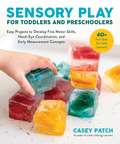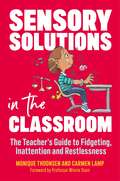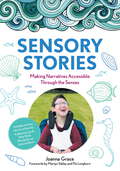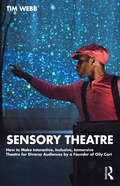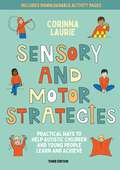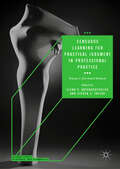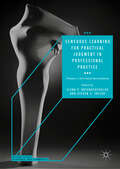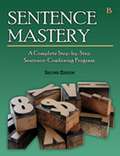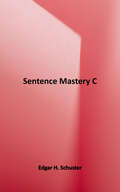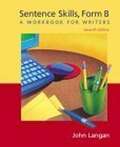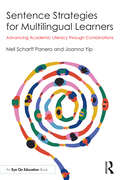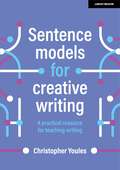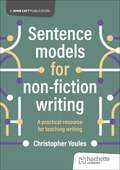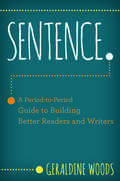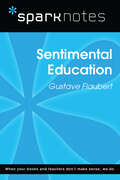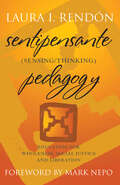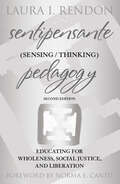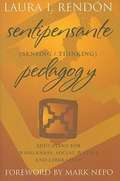- Table View
- List View
Sensory Play for Toddlers and Preschoolers: Easy Projects to Develop Fine Motor Skills, Hand-Eye Coordination, and Early Measurement Concepts
by Casey PatchExplore taste-safe small worlds, create colorful pieces of art, and engage all five senses while investigating the great outdoors. Sensory play is a wonderful way to explore the world with your little learners!Sensory Play for Toddlers and Preschoolers is a practical, hands-on guide for parents and educators who want to inject more play into their children's day! Since this collection features simple sensory play ideas with items you already have in your home, playtime has never been easier. Inside the book, you&’ll find forty easy sensory play tubs and activities with extra bonus ideas for extending the activities even further! Not only will your child be learning and exploring through play, but you&’ll also be creating some magical memories of playtime that will last a lifetime! Learn how to get started with sensory play using tips, tricks, and sensory play staples.Follow quick and easy, tried and tested sensory base recipes designed to ignite the senses and inspire hours of sometimes messy, always memorable playtime.Create thoughtful sensory invitations and artworks while developing fine motor skills, hand-eye coordination, early measurement concepts and so much more! Sensory play allows our little learners to make connections as they explore the world around them using their senses of sight, smell, taste, sound, and touch. It&’s the beginning of a lifelong journey of scientific understanding and a wonderful way to connect and bond with your little learners! Projects include: Rainbow RiceCloud DoughSand FoamEdible MudWater TubRainbow SpaghettiFrozen Building BlocksOutdoor KitchenJell-O Bug RescueBubble Wrap Paintingsand more!
Sensory Solutions in the Classroom: The Teacher's Guide to Fidgeting, Inattention and Restlessness
by Carmen Lamp Monique ThoonsenEvery teacher knows them - the students who are continuously balancing on their chair legs or who prefer to hide in their hoodies all day long. These students are using all kinds of tricks to be able to stay focused, as they are under- or overresponsive to sensory input and trying to restore their balance.Children who struggle with processing sensory input can experience a wide range of symptoms, including hypersensitivity to sound, sight and touch, poor fine motor skills and easy distractibility. Using this accessible, science-based guide, school staff can support these students by understanding their symptoms and how they impact their learning. Teachers can learn to look at students in a different way: through so-called 'SPi glasses', introduced in the book. With these glasses on, you learn to recognize behaviours linked to sensory processing and respond quickly, easily and with more understanding, without using a diagnosis, medication or therapy. The techniques provided help children feel settled and soothed at school, enabling them to learn and communicate better. Creating the perfect learning environment for all students - a sensory supportive classroom - this tried and tested guide is an essential tool for teachers (with or without prior knowledge of SPD), to better support and understand their students and their sensory needs.
Sensory Stories for Children and Teens with Special Educational Needs: A Practical Guide
by Joanna GraceSensory Stories are short stories of a few lines which are brought to life through a selection of meaningful sensory experiences. They are particularly beneficial for students with Sensory Processing Disorder (SPD), profound and multiple learning difficulties (PMLD), autism spectrum disorders (ASD) and other special educational needs (SEN). For children with PMLD, Sensory Stories can open up new avenues for communication and inclusive learning. For students with SPD and ASD, they offer a fun way of encountering sensory experiences and triggers in a safe, repetitive way, which over time can help to reduce associated anxieties. This accessible guide offers teachers, other professionals working with students with SEN and parents with a complete step-by-step guide to creating and using Sensory Stories effectively. Aiming to make Sensory Stories affordable and accessible to schools and parents alike by using everyday items found in the classroom and home, Joanna Grace provides original, ready-to-use Sensory Stories with accompanying lesson plans, games and activities and adaptations for different abilities and diagnoses. Written by an experienced SEN consultant and sensory learning specialist, this is unique and essential reading for teachers, other professionals and parents wishing to introduce the many benefits of multi-sensory storytelling to children in their care.
Sensory Stories to Support Additional Needs: Making Narratives Accessible Through the Senses
by Joanna GraceSensory Stories are short stories of a few lines which are brought to life through a selection of meaningful sensory experiences. They are particularly beneficial for people with Sensory Processing Disorder (SPD), Profound and Multiple Learning Difficulties (PMLD) and Autistic children or adults. Sensory stories are perfect for introducing new sensory environments in a safe, interactive way to help reduce associated anxieties and open up new avenues for communication and play.This updated edition is packed with original ready-to-use sensory stories, including 5 additional guest sensory stories by authors from around the world and your very own story template to create a sensory experience personalised for each person. With exclusive 'how to' video content and digital lesson plans, this book is the essential tool for introducing the transformative multi-sensory storytelling method into your home, classroom or group setting.Using everyday items and step-by-step instructions to make incorporating sensory stories accessible and simple, it has never been easier to create inclusive and fun sensory experiences to enhance the lives of those with additional needs.
Sensory Templates and Manager Cognition: Art, Cognitive Science And Spiritual Practices In Management Education (Palgrave Studies In Business, Arts And Humanities Ser.)
by Claus SpringborgThis book explores the role of art and spiritual practices in management education. It takes recent developments in cognitive science relating to the metaphorical and embodied nature of cognition as its starting point. Introducing the concept of ‘sensory templates’, Springborg demonstrates how managers unconsciously understand organizational situations and actions as analogous to concrete sensorimotor experiences, such as pushing, pulling, balancing, lifting, moving with friction, connecting and moving various substances. Real-life management and leadership case studies illustrate how changing the sensory templates one uses to understand a particular situation can increase managerial efficiency and bring simple solutions to problems that have troubled managers for years. Sensory Templates and Manager Cognition will be of interest to scholars and students of managerial cognition, leadership and neuroscience, as well as practising managers and management educators.
Sensory Theatre: How to Make Interactive, Inclusive, Immersive Theatre for Diverse Audiences by a Founder of Oily Cart
by Tim WebbSensory Theatre: How to Make Interactive, Inclusive, Immersive Theatre for Diverse Audiences by a Founder of Oily Cart is an accessible step-by-step guide to creating theatre for inclusive audiences, such as young people on the autism spectrum or affected by other neuro-divergent conditions and children under two. Conventional theatre relies on seeing and hearing to involve its audience; sensory theatre harnesses the power of five or more senses to address its participants who have different ways of relating to the world around them. This book is an insightful history of Oily Cart and its pioneering development of work for the very young, including Baby Theatre, and for neuro-divergent audiences including those on the autism spectrum. It gives a clear introduction to the fundamental concepts of this theatre, suggests a host of practical techniques drawn from over forty years of experience, and describes some of Oily Cart’s most radical innovations, including theatre on trampolines, in hydrotherapy pools, and with flying audiences in the company of aerial artists. The book also includes copious photos from the Oily Cart’s archives and links to videos examples of the company’s work. Readers will learn how to: Research the intended audience while not being led astray by labels. Create a welcoming, immersive sensory space in classrooms, nurseries, school halls, and playgrounds. Devise sensory stories that can be adapted to suit different audiences. Recruit, audition, cast, and run rehearsals. Ensure that the production is truly sensory and interactive. Written for Theatre for Young Audiences, Drama in Education, and specialized Applied Theatre courses, as well as educators and theatre practitioners interested in creating inclusive, interactive productions, Sensory Theatre offers a goldmine of ideas for making work that connects with audiences who can be the hardest to reach.
Sensory and Motor Strategies (3rd edition): Practical Ways to Help Autistic Children and Young People Learn and Achieve
by Corinna LaurieIn this fully revised third edition, Corinna Laurie sets out practical strategies to help autistic children develop their sensory and motor skills. Learn to identify possible challenges, recognise signs of overload and work in a co-productive way with your student or child, developing sensory regulation strategies and improving motor skills to aid well-being.The simple, low-cost activities provide practical solutions to help children meet the demands of any situation, building skills from handwriting and using scissors to improving posture, co-ordination and motor planning. Sensory strategies include calming techniques and simple environmental modifications to prevent overwhelm, among many others.Helping to improve functional abilities and enable children to thrive and build independence, this is an essential resource for anyone working with children on the autism spectrum.
Sensory-Balance: An Approach to Learning Media Assessment for Students With CVI
by Christine Roman-Lantzy Matthew TietjenThe current leading cause of visual impairment among children is not a disease or condition of the eyes, but cortical visual impairment (CVI)-also known as cerebral visual impairment-in which visual dysfunction is caused by damage or injury to the brain. The definition, nature, and treatment of CVI are the focus of great concern and widespread debate, and this complex condition poses challenges to professionals and families seeking to support the growth and development of visually impaired children. On the basis of more than 30 years' experience in working with hundreds of children of all ages with CVI, Christine Roman-Lantzy has developed a set of unique assessment tools and systematic, targeted principles whose use has helped children learn to use their vision more effectively. This one-of-a-kind resource provides readers with both a conceptual framework with which to understand working with CVI and concrete strategies to apply directly in their work.
Sensuous Learning for Practical Judgment in Professional Practice: Volume 1: Arts-based Methods (Palgrave Studies in Business, Arts and Humanities)
by Steven S. Taylor Elena P. AntonacopoulouThe first volume of this ground-breaking book critically examines how and why arts-based methods such as choir conducting workshops and dialogue improvisation can make a difference in improving professional practice. Taking a ‘human-centred’ approach, it delivers an insightful account of what these approaches do differently to achieve a new mode of learning – ‘sensuous learning’ – that cultivates professional judgment to serve the common good, simultaneously supporting personal and collective growth. The chapters present cutting edge examples of multiple ways arts-based methods underpin learning arenas for expanding leadership and improving professional practice. The reflexivity cultivated through these learning arenas has the unique potential to improve professional practice, not merely by enhancing competence but also by cultivating character and conscience, which is central in making judgments that serve the common good. These benefits are relevant for professional practitioners sharpening the skills and behaviours needed in organisations, including creativity, diversity, imagination, and improvisation.
Sensuous Learning for Practical Judgment in Professional Practice: Volume 2: Arts-based Interventions (Palgrave Studies in Business, Arts and Humanities)
by Steven S. Taylor Elena P. AntonacopoulouThe second volume of this ground-breaking book critically examines the effect of arts-based methods in combination as arts-based interventions in improving professional practice, from deinstitutionalization to the counteraction of destructive leadership. Taking a ‘human-centred’ approach, it delivers an insightful account of what these approaches do differently to achieve a new mode of learning – ‘sensuous learning’ – that cultivates professional judgment to serve the common good, simultaneously supporting personal and collective growth. The chapters present cutting edge examples of multiple ways arts-based interventions underpin learning arenas for expanding leadership and improving professional practice. The reflexivity cultivated through these learning arenas has the unique potential to improve professional practice, not merely by enhancing competence but also by cultivating character and conscience, which is central in making judgments that serve the common good. These benefits are relevant for professional practitioners sharpening the skills and behaviours needed in organisations, including creativity, diversity, imagination, and improvisation.
Sentence Mastery - Book B
by Edgar H. SchusterA Sentence-Combining Program Integrated with Practice in Basic Grammar, Usage, and Mechanics
Sentence Mastery - Book C, Second Edition
by Edgar H. SchusterThis book is for you. Its purpose is to help make you a better writer. It is based on an old idea--that one can improve a skill by practice. You know that batters improve by practicing hitting. Piano players improve by practicing the piano. Carpenters improve by practicing their trade. There is every reason to believe that you will improve as a writer by writing. Yet it is not certain that you will improve only by writing. Student writers who do not know certain fundamentals may merely repeat their errors. This book offers carefully controlled practice. If you can understand a few basic clues, you will not merely write sentences, you will write good sentences. By the time you have finished this book, you will have written hundreds of good sentences. You will be well on your way toward sentence mastery. In addition to writing good sentences, you will also gain practice in writing correct forms of words. For example, you will practice writing write and right, past and passed, to mention only two of the twenty items in this book. In the first problem or two in early lessons, we call attention to these troublesome words by printing them in boldfaced italics. Boldfaced italics look like this: write, right; past, passed. In later lessons you will receive much additional practice writing such troublesome words. Some people naturally work faster than others. If you are one of these fast workers, you will find extra practice for each lesson at the back of the book, beginning on page 129. If you finish any lesson before your classmates, turn to the proper page near the end of the book and you will find more sentences to do. This book may also help you to improve your punctuation, capitalization, spelling, and even your handwriting.
Sentence Skills: A Workbook for Writers, Form B
by John LanganThis best-selling sentence-level worktext by John Langan continues to help students master the essential grammar, mechanics, punctuation, and usage skills needed for clear, thoughtful writing. The seventh edition of Sentence Skills, Form B features a greater emphasis on prewriting and revision, a new chapter for non-native speakers, and much more!.
Sentence Strategies for Multilingual Learners: Advancing Academic Literacy through Combinations
by Nell Scharff Panero Joanna YipThis book presents Combinations as a set of high-yield instructional strategies for advancing academic literacy for multilingual learners and all students. It discusses the strategies themselves as well as how they work to advance content and language learning simultaneously, across the grades and content areas. The book is particularly beneficial for all teachers working with linguistically and culturally diverse learners to accelerate their language and content learning. Utilizing these strategies will not only greatly improve students’ writing but also supports their critical thinking, content area reading and language comprehension skills. This book argues for utilizing Combinations with Strategic Inquiry, presenting evidence of how each amplifies the impact of the other, and how together they address many of the challenges to learning new and counter-cultural methods and to establishing school and district cultures in support of multilingual learners’ success. This book is a great resource for classroom teachers, literacy coaches and school and district administrators who want to support multilingual learners and all students to thrive.
Sentence Strategies for Multilingual Learners: Advancing Academic Literacy through Combinations
by Nell Scharff Panero Joanna YipThis book presents Combinations as a set of high-yield instructional strategies for advancing academic literacy for multilingual learners and all students. It discusses the strategies themselves as well as how they work to advance content and language learning simultaneously, across the grades and content areas.The book is particularly beneficial for all teachers working with linguistically and culturally diverse learners to accelerate their language and content learning. Utilizing these strategies will not only greatly improve students’ writing but also supports their critical thinking, content area reading and language comprehension skills. This book argues for utilizing Combinations with Strategic Inquiry, presenting evidence of how each amplifies the impact of the other, and how together they address many of the challenges to learning new and counter-cultural methods and to establishing school and district cultures in support of multilingual learners’ success.This book is a great resource for classroom teachers, literacy coaches and school and district administrators who want to support multilingual learners and all students to thrive.
Sentence models for creative writing: A practical resource for teaching writing
by Christopher YoulesTeaching at sentence level is essential to improve writing. Knowing this, I desperately searched for a book packed full of sentence models that I could use to inspire my students. On discovering that no such book existed, I spent the next year poring over hundreds and hundreds of books to tap into the magic formula of what makes a great sentence. I sorted all these fantastic sentence structures into the domains through which we write stories: action, setting, character, feelings, physical effects, thoughts, the senses, and dialogue. This book contains hundreds of those sentence models. Each chapter also contains practical advice on effectively teaching the different aspects of story writing. The sentences can be used as creative writing exercises, inspiration for your exemplary text, or ideas for writing lessons. This book will reveal the magic formula behind great writing and give you a secret window into how this writing is created.
Sentence models for creative writing: A practical resource for teaching writing
by Christopher YoulesTeaching at sentence level is essential to improve writing. Knowing this, I desperately searched for a book packed full of sentence models that I could use to inspire my students. On discovering that no such book existed, I spent the next year poring over hundreds and hundreds of books to tap into the magic formula of what makes a great sentence. I sorted all these fantastic sentence structures into the domains through which we write stories: action, setting, character, feelings, physical effects, thoughts, the senses, and dialogue. This book contains hundreds of those sentence models. Each chapter also contains practical advice on effectively teaching the different aspects of story writing. The sentences can be used as creative writing exercises, inspiration for your exemplary text, or ideas for writing lessons. This book will reveal the magic formula behind great writing and give you a secret window into how this writing is created.
Sentence models for non-fiction writing
by Christopher YoulesAre your students struggling to write clear, concise, and engaging non-fiction prose? Offering a wealth of sentence models and advice, this practical book provides everything you need to help students of all ages to craft compelling sentences and learn the essential elements of effective non-fiction writing.The comprehensive coverage includes: selecting engaging topics for non-fiction writing; planning a structure; and tailoring the style to the audience. Improve your students' clarity and coherence and enable them to master the art of writing in different non-fiction genres, including informative writing and persuasive writing.
Sentence models for non-fiction writing
by Christopher YoulesAre your students struggling to write clear, concise, and engaging non-fiction prose? Offering a wealth of sentence models and advice, this practical book provides everything you need to help students of all ages to craft compelling sentences and learn the essential elements of effective non-fiction writing.The comprehensive coverage includes: selecting engaging topics for non-fiction writing; planning a structure; and tailoring the style to the audience. Improve your students' clarity and coherence and enable them to master the art of writing in different non-fiction genres, including informative writing and persuasive writing.
Sentence.: A Period To Period Guide To Building Better Readers And Writers
by Geraldine WoodsSometimes it’s better to start small, with a sentence. Every English teacher has experienced it: students staring at an empty page, seemingly paralyzed by a writing assignment. When this happens, it may be time to back off from the Big Idea approach to the art of reading and writing, and zero in on a single sentence. In this book, a master teacher offers a complete guide to a sentence-level approach. Helping students recognize the techniques that make sentences great is the first step, and there are plenty of examples here from YA novels, TV shows, and song lyrics as well as the novels, poetry, and nonfiction pieces that form the canon of middle and high school reading lists. Lesson plans include activities to introduce the featured element of style; questions to guide students in their analysis; and writing prompts and activities to spark students’ interest and creativity. With this Little-to-Big strategy, students move quickly from analysis of the words between two periods to the universe of ideas of which that sentence is a part. They may even be eager to write their own
Sentimental Education (SparkNotes Literature Guide Series)
by SparkNotesSentimental Education (SparkNotes Literature Guide) by Gustave Flaubert Making the reading experience fun!Created by Harvard students for students everywhere, SparkNotes is a new breed of study guide: smarter, better, faster. Geared to what today's students need to know, SparkNotes provide:Chapter-by-chapter analysisExplanations of key themes, motifs, and symbolsA review quiz and essay topicsLively and accessible, these guides are perfect for late-night studying and writing papers.
Sentipensante (Sensing / Thinking) Pedagogy: Educating for Wholeness, Social Justice and Liberation
by Laura I. Rendón“Challenging, inspiring, beautifully written, and unusual, this book calls readers to find ways to link mind and heart -- thinking and feeling -- to transform teaching and learning in higher education. Laura Rendón has illustrated how one can unite one's deep beliefs, values, and feelings, with one's keen analytical and intellectual abilities...an important, thought-provoking, and unique addition to the literature on teaching, learning, and the academic life.”—The Review of Higher Education on the first editionThis new and expanded edition of the acclaimed and successful book by nationally-recognized student advocate, activist scholar and contemplative educator, Laura Rendón, will surely find new audiences who are eager to create teaching and learning environments where the learner is fully present and engaged using the full capacities of mind, body and senses; and where the learning experience can be simultaneously subjective and objective, a view which challenges the privileged notion that only reason and objective modes of learning are valid. While the pedagogy can be employed with all students, Rendón provides support for faculty who work with low-income, first-generation, and racially-minoritized learners. Sentipensante Pedagogy benefits all students through holistically meeting their emotional needs and quest for knowledge, and simultaneously fostering their civic sense, critical consciousness, and community engagement.Rendón offers an inspirational and contemplative pedagogy that leverages student assets and addresses the rhythmic balance and interconnection between intellectual, social, emotional, and inner-life skill development. The book blends academic discussions about pedagogy and diverse world views as it inspires a new generation of faculty and staff to develop blueprints for democratic, decolonial teaching and learning environments.The sensing / thinking approach has been successfully adopted and adapted in courses and seminars across many academic disciplines, including STEM, in two- and four-year colleges institutions. Several colleges and universities have created centers around contemplative studies and pedagogy with applications extending to the K-12 education arena.As with adopting any new pedagogical approach, planning and thought needs to be given on how to integrate its reflective and creative elements with course content. This book offers inspiration and guidance for faculty who want to holistically address the needs, aspirations, and individual development of their students
Sentipensante (Sensing / Thinking) Pedagogy: Educating for Wholeness, Social Justice, and Liberation
by Laura I. Rendón“Challenging, inspiring, beautifully written, and unusual, this book calls readers to find ways to link mind and heart -- thinking and feeling -- to transform teaching and learning in higher education. Laura Rendón has illustrated how one can unite one's deep beliefs, values, and feelings, with one's keen analytical and intellectual abilities...an important, thought-provoking, and unique addition to the literature on teaching, learning, and the academic life.”—The Review of Higher Education on the first editionThis new and expanded edition of the acclaimed and successful book by nationally-recognized student advocate, activist scholar and contemplative educator, Laura Rendón, will surely find new audiences who are eager to create teaching and learning environments where the learner is fully present and engaged using the full capacities of mind, body and senses; and where the learning experience can be simultaneously subjective and objective, a view which challenges the privileged notion that only reason and objective modes of learning are valid. While the pedagogy can be employed with all students, Rendón provides support for faculty who work with low-income, first-generation, and racially-minoritized learners. Sentipensante Pedagogy benefits all students through holistically meeting their emotional needs and quest for knowledge, and simultaneously fostering their civic sense, critical consciousness, and community engagement.Rendón offers an inspirational and contemplative pedagogy that leverages student assets and addresses the rhythmic balance and interconnection between intellectual, social, emotional, and inner-life skill development. The book blends academic discussions about pedagogy and diverse world views as it inspires a new generation of faculty and staff to develop blueprints for democratic, decolonial teaching and learning environments.The sensing / thinking approach has been successfully adopted and adapted in courses and seminars across many academic disciplines, including STEM, in two- and four-year colleges institutions. Several colleges and universities have created centers around contemplative studies and pedagogy with applications extending to the K-12 education arena.As with adopting any new pedagogical approach, planning and thought needs to be given on how to integrate its reflective and creative elements with course content. This book offers inspiration and guidance for faculty who want to holistically address the needs, aspirations, and individual development of their students
Sentipensante (Sensing/Thinking) Pedagogy: Educating For Wholeness, Social Justice and Liberation
by Mark Nepo Laura I. RendónLaura Rendon is a scholar of national stature, known for her research on students of color and first-generation college students, and on the factors that promote and impede student success. The motivation for the quest that Laura Rendon shares in this book was the realization that she, along with many educators, had lost sight of the deeper, relationship-centered essence of education, and lost touch with the fine balance between educating for academics and educating for life. Her purpose is to reconnect readers with the original impulse that led them to become educators; and to help them rediscover, with her, their passion for teaching and learning in the service to others and for the well being of our society. She offers a transformative vision of education that emphasizes the harmonic, complementary relationship between the sentir of intuition and the inner life, and the pensar of intellectualism and the pursuit of scholarship; between teaching and learning; formal knowledge and wisdom; and between Western and non-Western ways of knowing. In the process she develops a pedagogy that encompasses wholeness, multiculturalism, and contemplative practice, that helps students transcend limiting views about themselves, fosters high expectations, and helps students to become social change agents. She invites the reader to share her journey in developing sentipensante pedagogy, and to challenge seven entrenched agreements about education that act against wholeness and the appreciation of truth in all forms. She offers examples of her own teaching and of the classroom practices of faculty she encountered along the way; as well as guidance on the challenges, rewards and responsibilities that anyone embarking on creating a new vision of teaching and learning should attend to. Though based on the author's life work in higher education, her insights and approach apply equally to all teaching and learning contexts.
